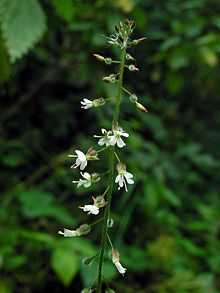Circaea
| Circaea | |
|---|---|
 | |
| Circaea lutetiana | |
| Scientific classification | |
| Kingdom: | Plantae |
| (unranked): | Angiosperms |
| (unranked): | Eudicots |
| (unranked): | Rosids |
| Order: | Myrtales |
| Family: | Onagraceae |
| Genus: | Circaea Tourn. ex L. |

The genus Circaea contains 7–10 species of flowering plants, known as Enchanter's nightshade. They are woodland plants occurring throughout the temperate regions of the Northern Hemisphere. Two species are widespread, Broad-leaved Enchanter's Nightshade (Circaea lutetiana) and Alpine Enchanter's Nightshade (Circaea alpina). In addition, there is an intermediate hybrid between these two, and several local species or subspecies, with between eight and 14 forms recognised by different authorities. The hybrid is sterile, persisting only by vegetative reproduction and not producing seeds.

This plant spreads its seeds by producing burrs that adhere to clothing, fur and feathers.
Circaea is in the family Onagraceae, which also includes willowherbs, evening primroses and fuchsias. The genus is named after the enchantress Circe from Greek mythology, who is supposed to have used enchanter's nightshade in her magic. Enchanter's nightshade is not related to the nightshade family that includes deadly nightshade and the Solanum genus (the Solanaceae).
- Species
- Circaea alpina (Alpine Enchanter's-nightshade)
- Circaea alpina subsp. alpina
- Circaea alpina subsp. angustifolia
- Circaea alpina subsp. caulescens
- Circaea alpina subsp. imaicola
- Circaea alpina subsp. micrantha
- Circaea alpina subsp. pacifica
- Circaea canadensis (syn. C. lutetiana subsp. canadensis)
- Circaea cordata
- Circaea erubescens
- Circaea glabrescens
- Circaea lutetiana (Enchanter's-nightshade)
- Circaea mollis
- Circaea quadrisulcata (syn. C. canadensis subsp. quadrisulcata)
- Circaea repens
- Hybrids
- Circaea × intermedia (C. alpina × C. lutetiana) (Upland Enchanter's-nightshade)
External links
- Natural England. Accessed July 2011
- English Country Garden Accessed July 2011
- Plant Identification UK Accessed July 2011